Lyon Old Town is a Renaissance district at the foot of the Fourvière Hill. With its paved old streets, colourful façades and secret passageways (les Traboules), the Vieux-Lyon was crucial in getting the city listed as a World Heritage Site by Unesco. The historical area has remained almost intact for centuries thanks to French government policy in the 1960s. In fact, Lyon Old Town is my favourite part of town… and I’m delighted to reveal it to you! Let’s start the visit!
Lyon Old Town: what is it?
Lyon Old Town is a historical district with houses from the Renaissance era.
It was the main part of the town in the 16th century.
Then people progressively started to lose interest in that area. The new trendy place was the Presqu’île, a peninsula between the Saône and Rhône rivers.
Some parts of “Vieux-Lyon” even became unhealthy during the first half of the 20th century.
André Malraux, the saviour of Lyon Old Town
In 1962, André Malraux, then French Minister of Culture, chose Lyon Old Town as France’s first “secteur sauvegardé” (protected area).
Malraux quite saved the “Vieux-Lyon” area from destruction.
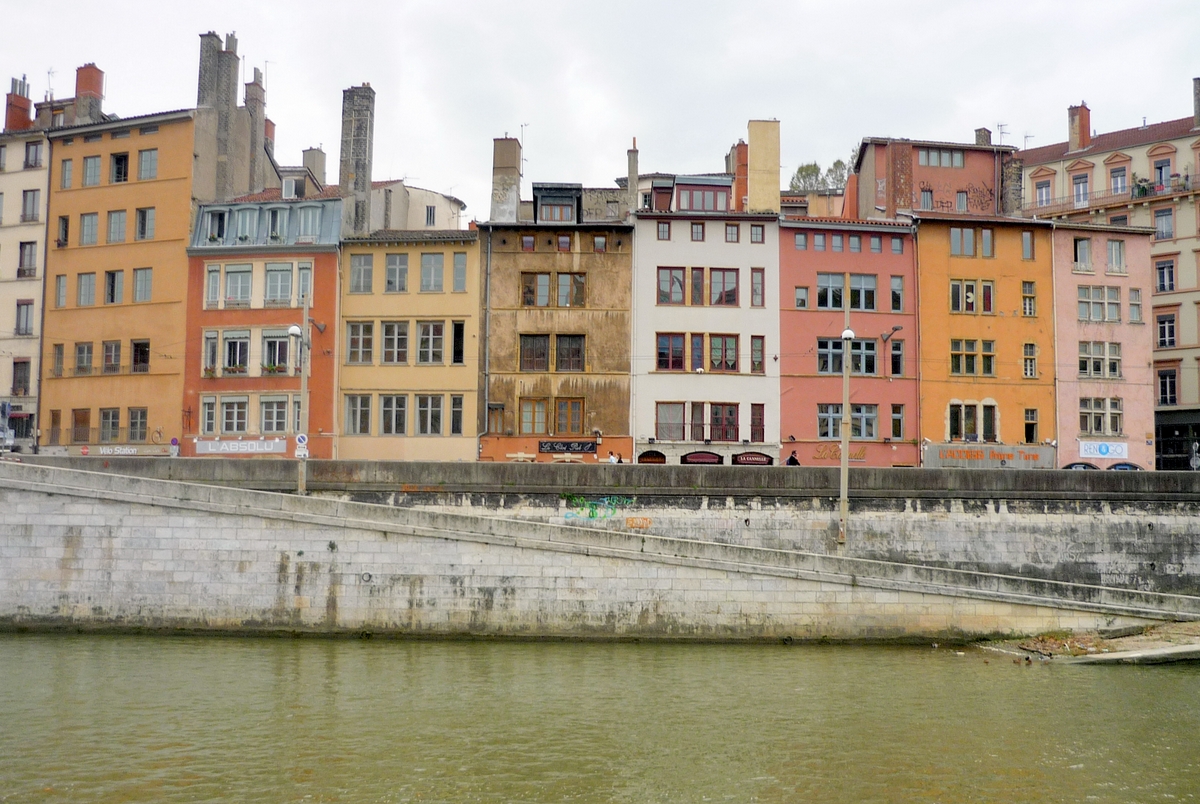
In 1957, having been elected Lyon’s mayor, Louis Pradel wanted to demolish a vital part of the Old Town buildings. He planned to dismantle the unsanitary houses and blocks to build… an expressway!
However, thanks to Malraux, this project could not become a reality, and the unhealthy parts of the Old Town were refurbished.
In 1998, Unesco listed the Vieux-Lyon as a World Heritage Site.
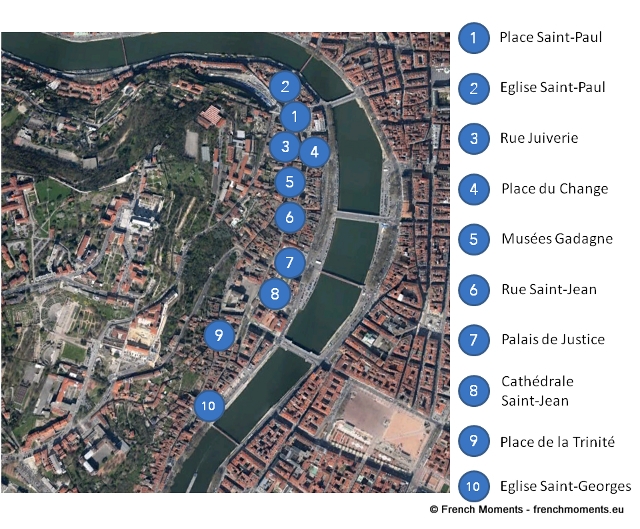
The three districts of Lyon Old Town
Lyon Old Town is divided into three districts, all referring to Christian saints.
- The Northern Old Town is the “Saint-Paul” district. It took its name from the Church it surrounds, known as église St Paul.
- The Old Town Centre is named “Saint-Jean” (St John). As for St Paul, the name also refers to a religious building. Indeed, Lyon’s cathedral is dedicated to “Saint-Jean”, after one of the most powerful chapters in the Church in the Middle Ages, related to John the Baptist.
- The Southern Old Town is the “Saint-Georges” district. It refers to a Christian martyr of the 4th century. Again, a church in this area is named église Saint-Georges.
Get the Lyon City Pass
Unlock the treasures of Lyon with the exclusive Lyon City Card, available for 24 hours, 48 hours, 72 hours, or 96 hours. This card grants you access to the city’s wonders. This card pays for itself with just a visit to two attractions, making it a smart choice for your Lyon exploration.
Highlights of the Lyon City Card:
- Seamlessly traverse the city with unlimited access to Lyon’s public transport system.
- Immerse yourself in culture with entry to 25 museums and their fascinating temporary exhibitions.
- Delight in a leisurely cruise along the Saône River, offering a moment of relaxation amidst Lyon’s enchanting scenery.
- Embark on captivating guided tours through the city’s historic districts as knowledgeable guides unveil the fascinating stories of Lyon’s past.
- Enjoy valuable discounts on shopping and theatre experiences, enhancing your Lyon adventure with added savings.
The Lyon City Card is your golden ticket to an unforgettable experience. It provides convenience, cultural enrichment, and delightful discoveries throughout your stay in this vibrant French city.
Where to stay in Lyon Old Town?
You can choose from a great range of accommodations in the old town of Lyon, from hotels to B&B!
When possible, don’t wait until the last minute to book, as finding hotel rooms can be a problem, especially on weekdays.
To book your accommodation in Lyon, click on this affiliate link, which will redirect you to our partner booking.com… or use the interactive map below:
Let’s start the visit to the picturesque old town of Lyon…
Northern Old Town: Quartier Saint-Paul
1) Place et Gare de Saint-Paul
(St Paul Square and railway station)
Let’s start our journey within Lyon Old Town in the North of this unique area, Saint-Paul district.
Place Saint-Paul is the first gate to “Vieux-Lyon” from Northern Presqu’île, especially from Place des Terreaux (Terreaux square).
However, it is not representative of the rest of the Old Town. Even though people lived there at the end of the Roman era, Place Saint-Paul became important only at the end of the 19th century, especially when the authorities decided to build a railway station in the area.
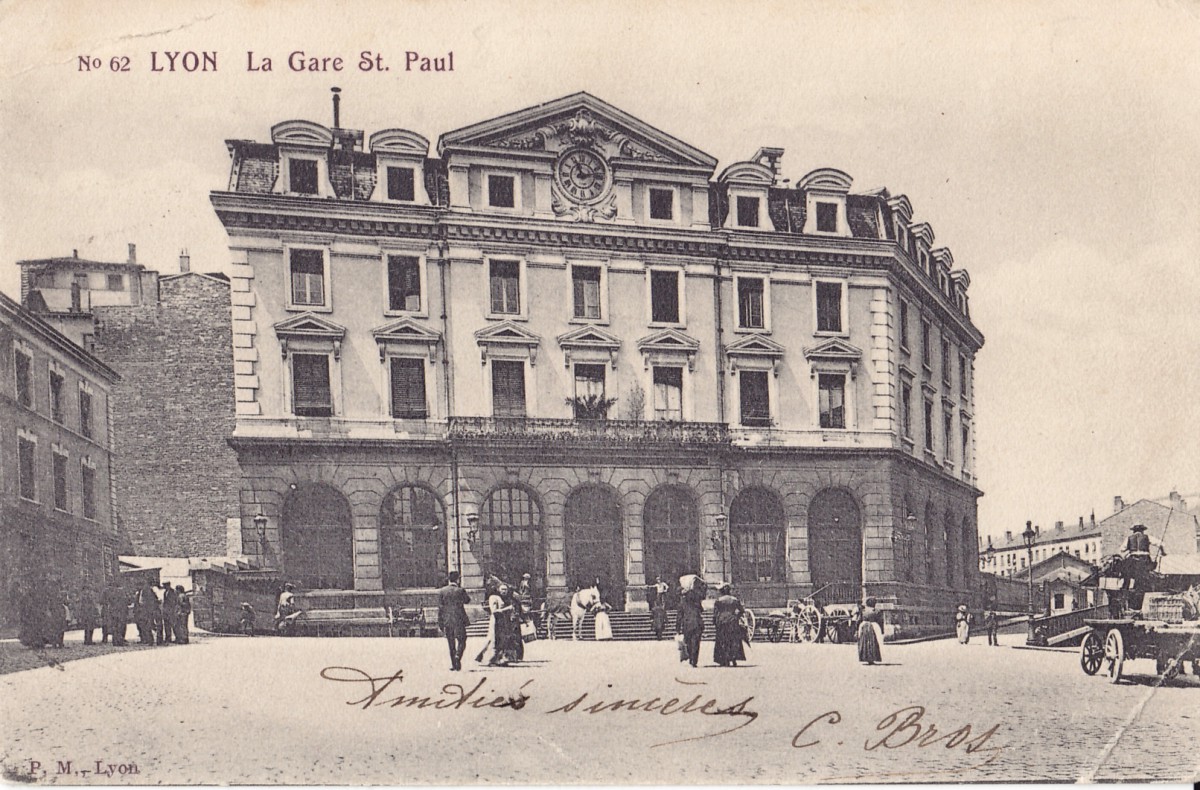
Lyon’s first railway station, Perrache in the Presqu’île, has operated since the 1850s. However, it mainly linked cities to the South and East of Lyon.
1873 saw the opening of the “Gare de Saint-Paul”. The railway station offered links to regional cities in the West (such as Montbrison, Lozanne and L’Arbresle).
At the end of the 20th century, with the construction of Part-Dieu railway station, St.Paul station became almost unused.
Nevertheless, it was restored a few years ago as part of a new project: the “Tram-Train de l’Ouest Lyonnais” (Western Lyon tram-train). To reduce the number of cars coming into Lyon via the crowded Fourvière axis, a tram-train was created between the Western suburbs of L’Arbresle, Lozanne and Brignais and Lyon’s city centre. The tram-train gave St Paul station a second life!
Place Saint-Paul
The square is a connecting hub between Vieux-Lyon and the city’s North. The square’s oldest and most beautiful building dates from the 17th century—the other buildings date from the end of the 19th century, contemporary with the station.
As a gate to inner Lyon, the square leads to the main points of the city courtesy of Trolleybus C3. One of the most utilised bus lines in Lyon’s metropolitan area, Trolleybus C3, will take you to the main spots in the city: Place des Terreaux, Rue de la République, Part-Dieu shopping centre and the railway station.
2) Église Saint-Paul
St Paul church
To the North of Place Saint-Paul, you can see the église Saint-Paul (St Paul church). It is one of the oldest churches in Lyon. In the Middle Ages, the St Paul church was the centre of a self-sufficient area, enclosed by its walls. During the Renaissance era, merchants used the area of the Church as a commercial centre.
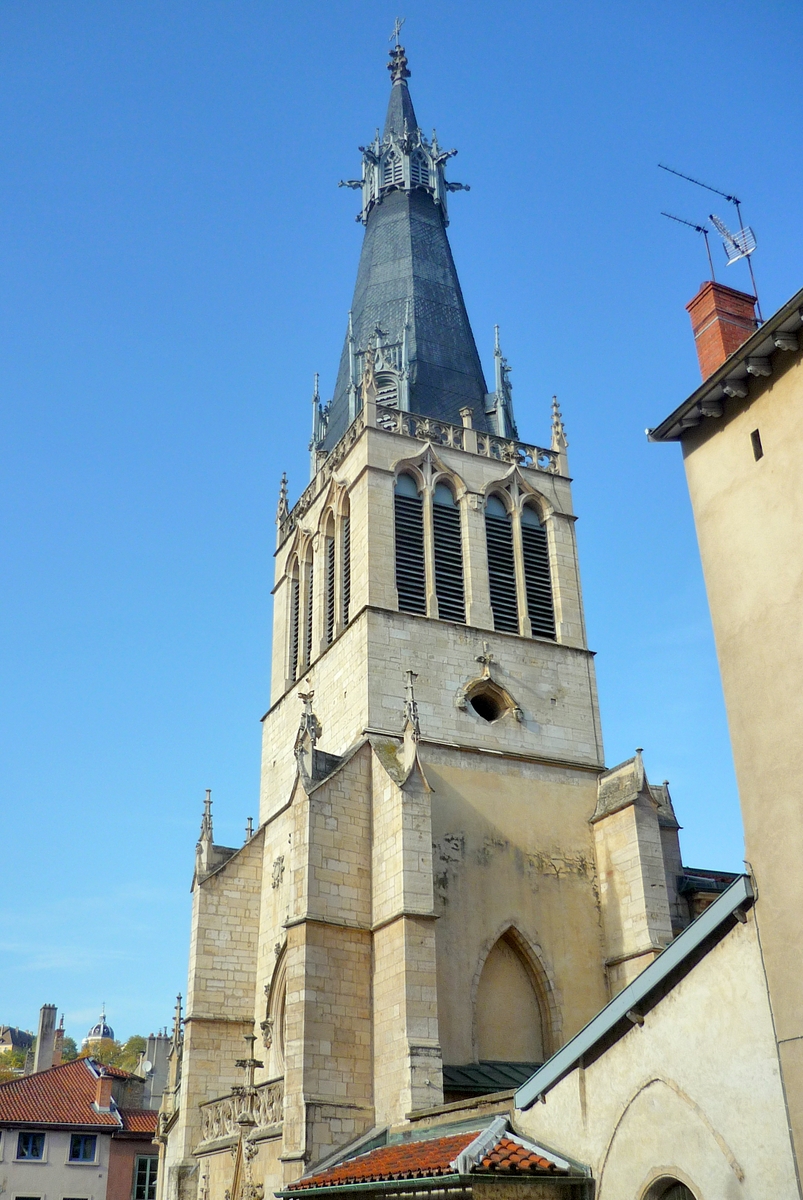
A former church stood on the site from 549 to the middle of the 9th century when it was knocked down and replaced by today’s structure. As you might guess, it has been evolving for the last 1,200 years. Indeed, the building only took its current shape in the 19th century!
The original building was built in the Romanesque style. Various alterations between the late 13th and 15th centuries brought a Gothic style to parts of the church.
Nowadays, the whole building is a mix of Romanesque and Gothic architecture, making it very special and unique in Lyon.

Outside the church
Look for an octagonal dome. With two rows of arcading, it is in Romanesque style. However, the steeple and the skylight at the top of the dome drew their inspiration from the Gothic style.
Inside the church
The eastern nave’s arches are Romanesque. The Western ones look Gothic. This mixture is also present in several chapels located around the church.
Finally, the church’s decoration features the city of Lyon. For example, in the transept, you will see 20th-century stained glass windows representing the martyrs of Lyon. The Romans executed these first Christians between the 1st and 4th centuries.
3) Rue Juiverie
Street of the Jews
Head south from place Saint-Paul via Rue Juiverie.
This is a little paved and car-free street, like most streets in Old Town. The street dates back to the Roman era. In the late Middle Ages, many Jews started moving there, giving the street its current name.
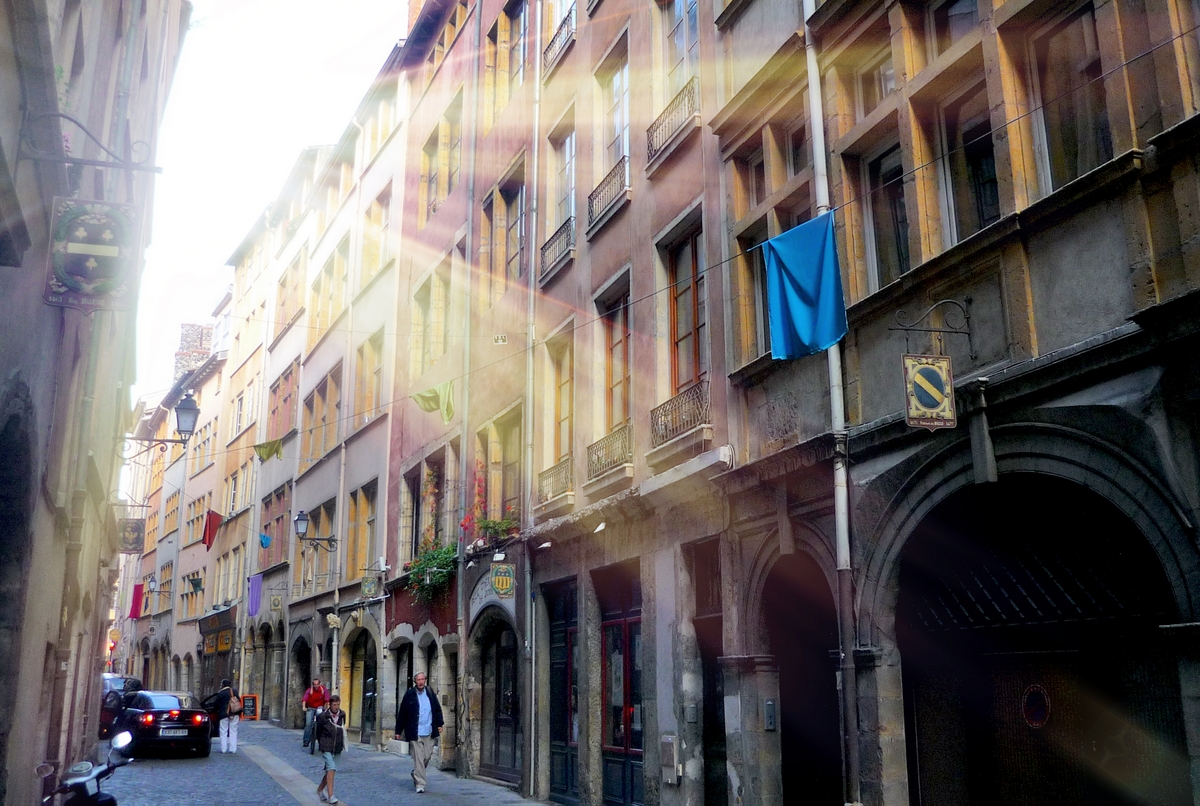
In the late 15th century, the street underwent a significant refurbishment. The cattle market that occupied the site moved elsewhere so richer merchants and bankers could move into the area. Most of them were Jewish then since the Catholic authorities forbade them to lend money for interest, according to religious rules.
A Renaissance jewel
The current streetscape dates from the Renaissance, especially all the building facades.
Some of them are quite beautiful and are worth seeing.
At number 8, you will see one of Lyon’s architectural wonders. In 1536, the General des Finances of King François I, Antoine Billoud, owned a two-part building in Rue Juiverie. He commissioned architect Philippe Delorme to create a gallery between them.
The famous apothecary Nostradamus from Saint-Rémy-de-Provence lived in this street for some time during the 16th century. He was well known for his prophecies. Rumour has it that Queen Catherine de’ Medici was keen on visiting him to learn more about her future…
4) Place du Change
Exchange Square
Like Rue Juiverie, the Place du Change (Exchange Square) symbolises the business activities in the Old Town of Lyon during the Renaissance era. In those days, the “Vieux-Lyon” was the city’s business centre. Many merchants and bankers lived there. Until the mid-17th century, merchants used to work in the open square.
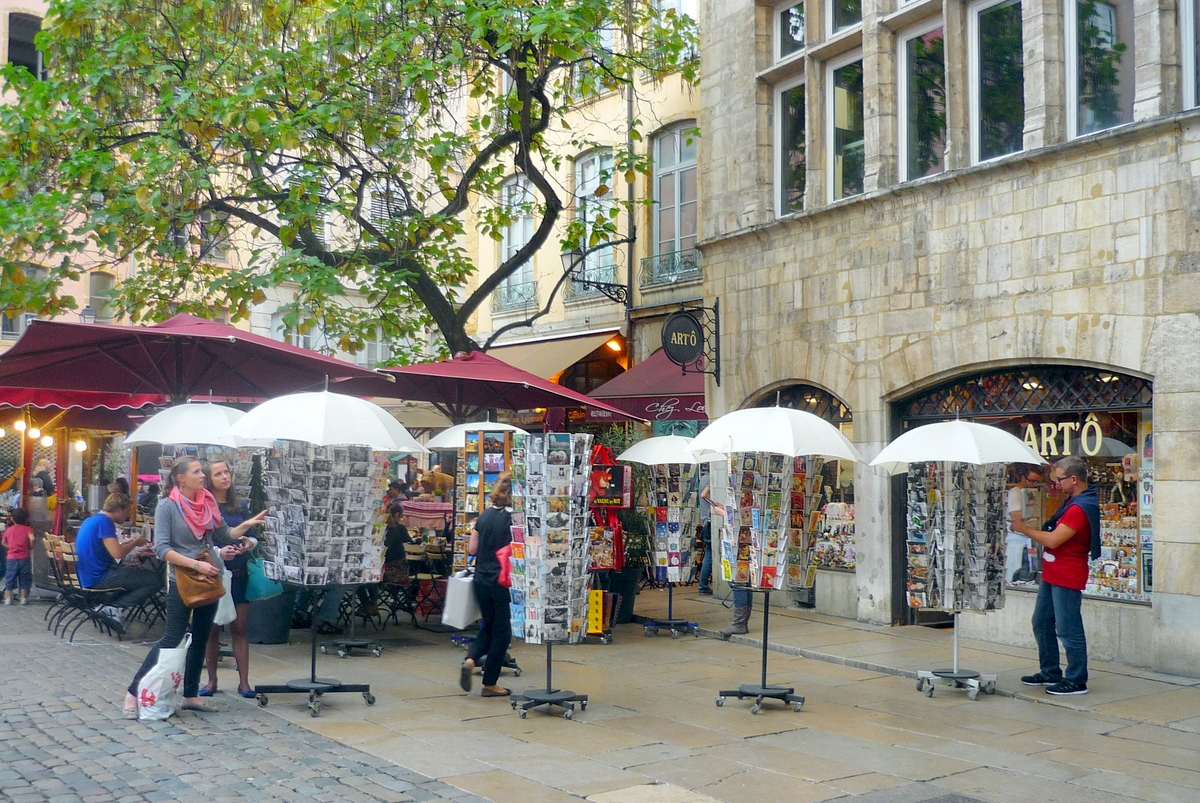
One of the loveliest squares in Lyon Old Town
Old buildings surround the little paved square. For instance, one of them (at number 2) has a roof that dates from the 13th century!
The Loge du Change
The original edifice of the Loge du Change (Exchange Loge) dates back to 1653. A hundred years later, due to the growing commercial activity, Jean-Baptiste Roche and Jacques-Germain Soufflot had it enlarged. These are the same architects who designed the first opera house in Lyon.
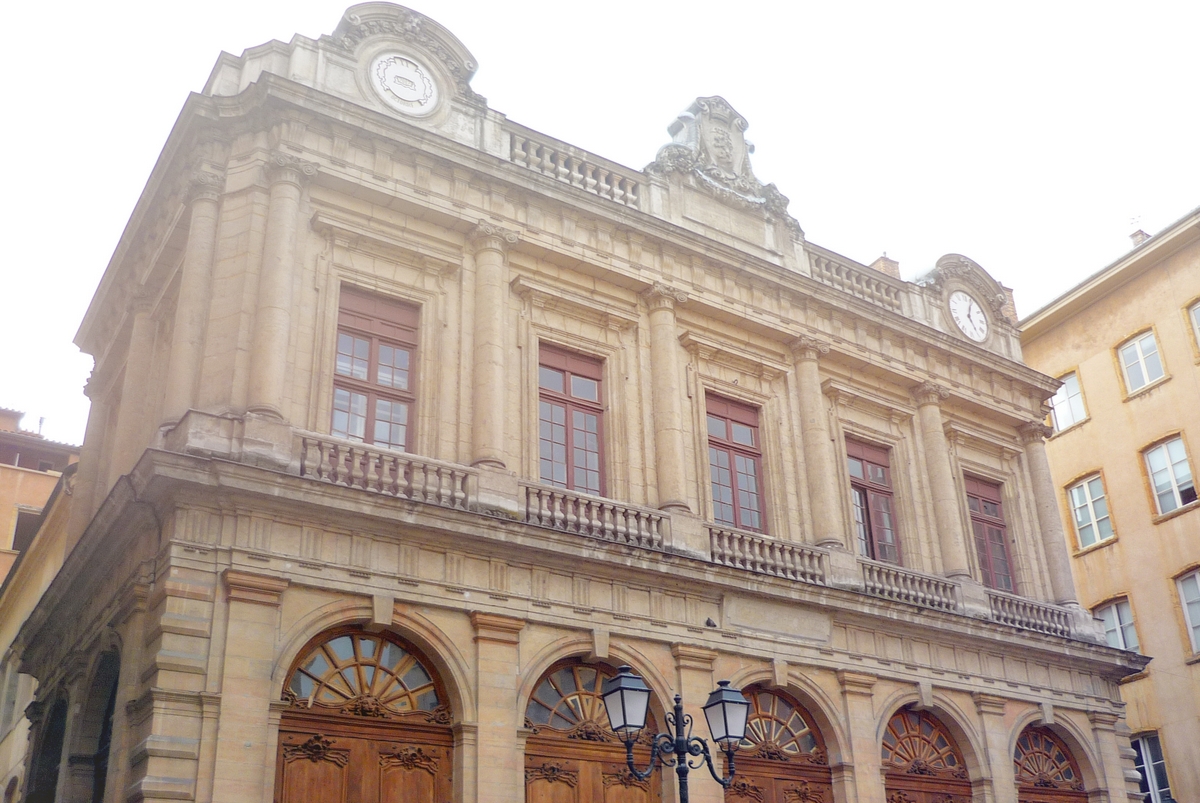
However, when the French Revolution started, merchants abandoned the lodge. It remained unused for almost fifteen years.
In 1803, the municipality of Lyon was looking for a building to house the Protestants of the town. After various offers, the Protestants decided to use the lodge, which was quite suitable for their needs. A few years ago, the clock that was missing from the beginning was installed on the façade.
By the River Saône
From Place du Change, you can go to the west and immediately reach the right bank of the Saône. The Old Town was built along the river.
From North to South of the “Vieux-Lyon”, next to the Saône, you can see impressive buildings painted with warm colours. These are a hallmark of Lyon Old Town—one of the reasons why Unesco listed the area as a World Heritage site in 1998.
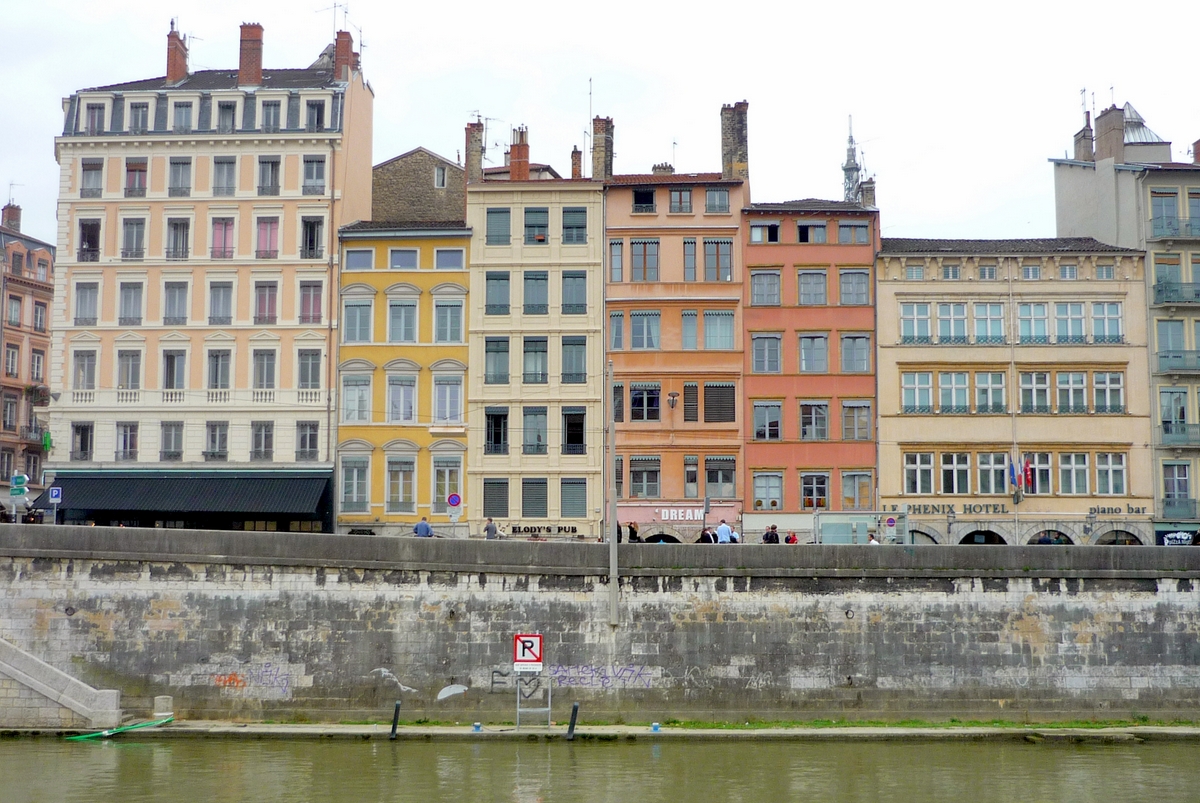
Central Old Town: Quartier Saint-Jean
Going on to the south, you will reach the Saint-Jean area inside “Vieux-Lyon”. It is the major part of Old Town containing the main buildings of interest, such as Lyon’s cathedral.
5) Les Musées Gadagne
Gadagne Museums
Fifty metres south of the Exchange Lodge, at the beginning of Rue du Boeuf (Beef Street), you will reach a rather large building with unique architecture. The “Hôtel de Gadagne” now houses the “Musées Gadagne” (Gadagne Museums).
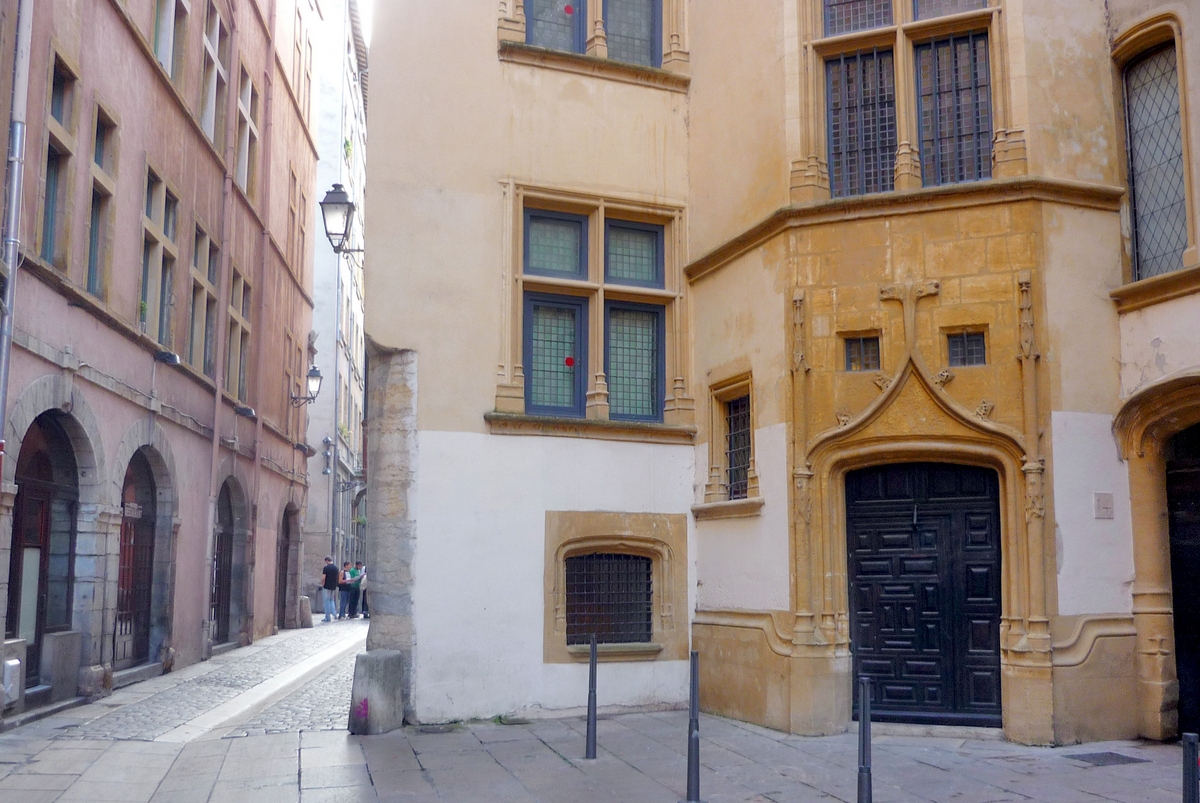
The Hôtel de Gadagne was built at the beginning of the 16th century.
Its architecture is quite surprising. The townhouse comprises two towers located at each side of the building, containing stairs to reach the upper parts of the townhouse.
Two brothers living in discord
Two bankers from a well-known family from Florence lived there: the Gadagnes brothers. Soon after moving into the townhouse, they got into a fight.
However, instead of one of them leaving the townhouse, they decided to cohabit in two separate wings of the building… Each of them enjoys his wealth to organise the biggest parties in town!
The Gadagnes were so rich that they inspired a well-known Lyonnaise expression: “riche comme Gadagne” (as rich as the Gadagnes). Nowadays, the municipality of Lyon owns the historic townhouse. Critical archaeological excavations took place there during the renovations in the 2000s.
Lyon historical museum
Since 1921, the Hôtel de Gadagne has housed the “Musée Historique de la Ville de Lyon” (Lyon historical museum).
Inside, you can discover some testimonies of the town’s history, beginning from the Roman era. The museum comprises 30 rooms, each one displaying important documents.

The Museum of World Puppets
In 1950, the building housed a second museum: the “Musée des Arts de la Marionette” (Museum of Artistic Puppets).
It seems pretty appropriate for this museum to be located in Lyon. Indeed, puppets have been an essential part of the city and the regional culture for centuries.
![Polichinelle at the Musée des arts de la marionnette © Romainbehar - licence [CC0] from Wikimedia Commons](https://frenchmoments.eu/wp-content/uploads/2013/05/Musée-des-arts-de-la-marionnette-Polichinelle-©-Romainbehar-licence-CC0-from-Wikimedia-Commons.jpg)
At the beginning of the 19th century, Laurent Mourguet created the emblematic Guignol puppet. Today, It remains one of the most famous examples of Lyon’s culture in France and all around the World. Guignol is also an essential symbol of the “Parler Lyonnais”, the local dialect. In the museum, you can see more than 2,000 different puppets which form part of the town’s history.
6) Rue Saint-Jean
St. John street
When leaving the Musées Gadagne, you can easily reach Rue Saint-Jean by Rue de la Fronde (Revolt Street).
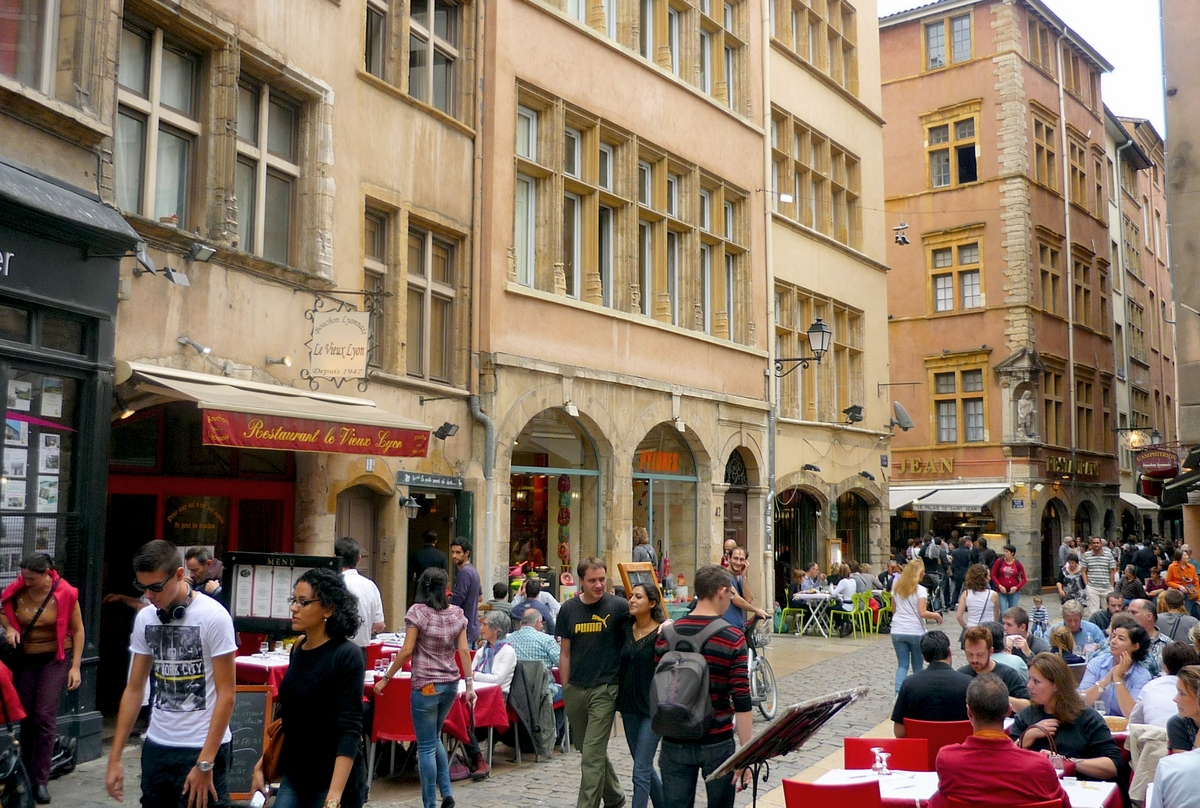
Rue Saint-Jean is the main street of Lyon Old Town. In fact, it is one of the most popular and visited streets in Lyon. It stretches 500 metres from north to south, from Place du Change to Place Saint-Jean. It leads to the eponymous Cathedral.
The origins of Rue Saint-Jean
The street was built at the end of the 3rd century. At that time, the people living on the Fourvière Hill (the city centre during the Roman era) faced difficulties with their water supply. They needed to go down the hill to obtain water.
It soon became the most crucial street in Lyon. It remained so until the creation of rue de la République and rue du Président Edouard-Herriot (in the Presqu’île) in the late 19th century.

The Traboules, a particularity of Lyon
As a typical street from the “Vieux-Lyon”, Rue Saint-Jean gives way to “traboules”.
These are common in Lyon and a few other cities of France’s Central East, such as Mâcon, Saint-Etienne and Chambéry.
Traboules are pathways joining two streets, going through several buildings.

They date from the Renaissance era. During World War II, Resistance fighters hid there their clandestine activities.
What does the word ‘traboule’ mean?
The word is part of the “Parler lyonnais” regional patois, and you will never hear it far from Lyon! The term “traboule” comes from “tra-bouler”, which means “roll through”.
You can find 230 traboules in Lyon, although many are closed to public access. In Lyon Old Town, you can walk through 33 of them.
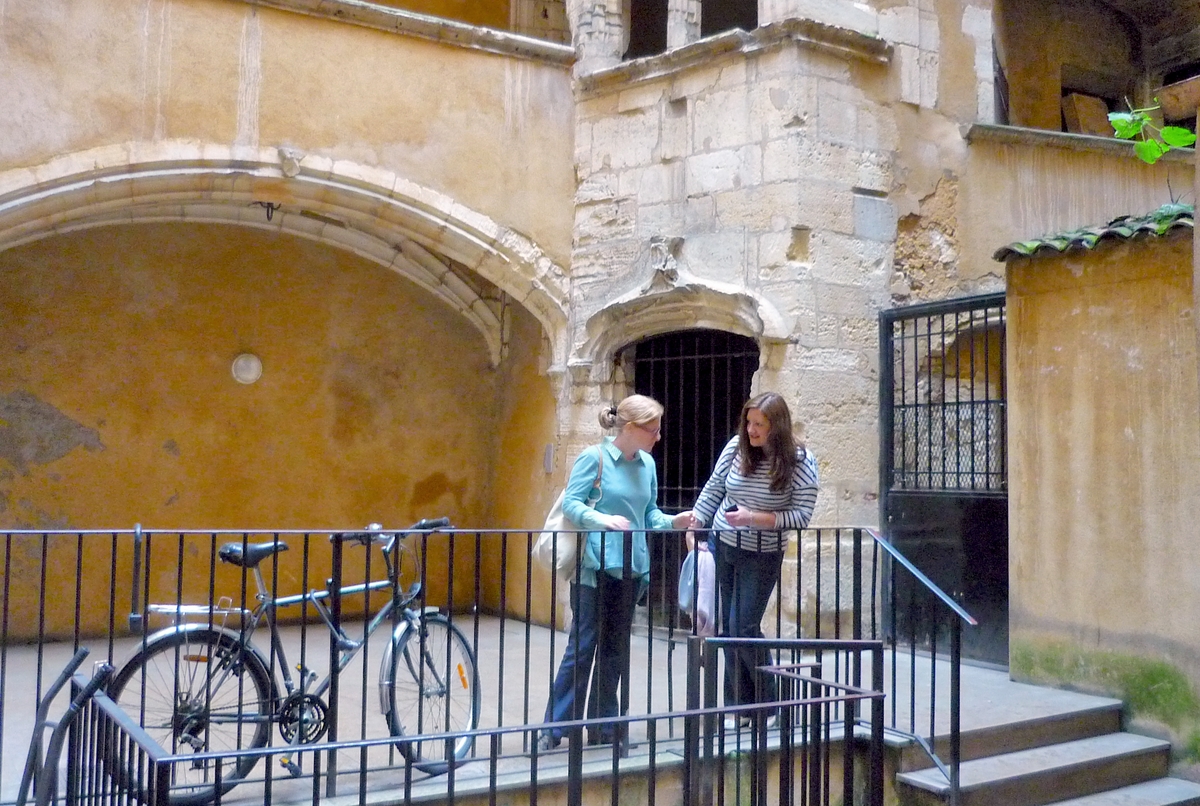
Lyon’s longest traboule
The longest traboule is located at number 54, Rue Saint-Jean. It goes through five courtyards to reach Rue du Boeuf, at number 27. Going through traboules is enjoyable, and you feel like a real local!

You’ll get to explore little-known treasures of Lyon, such as secretive courtyards, impressive staircase towers and long corridors that look like tunnels.


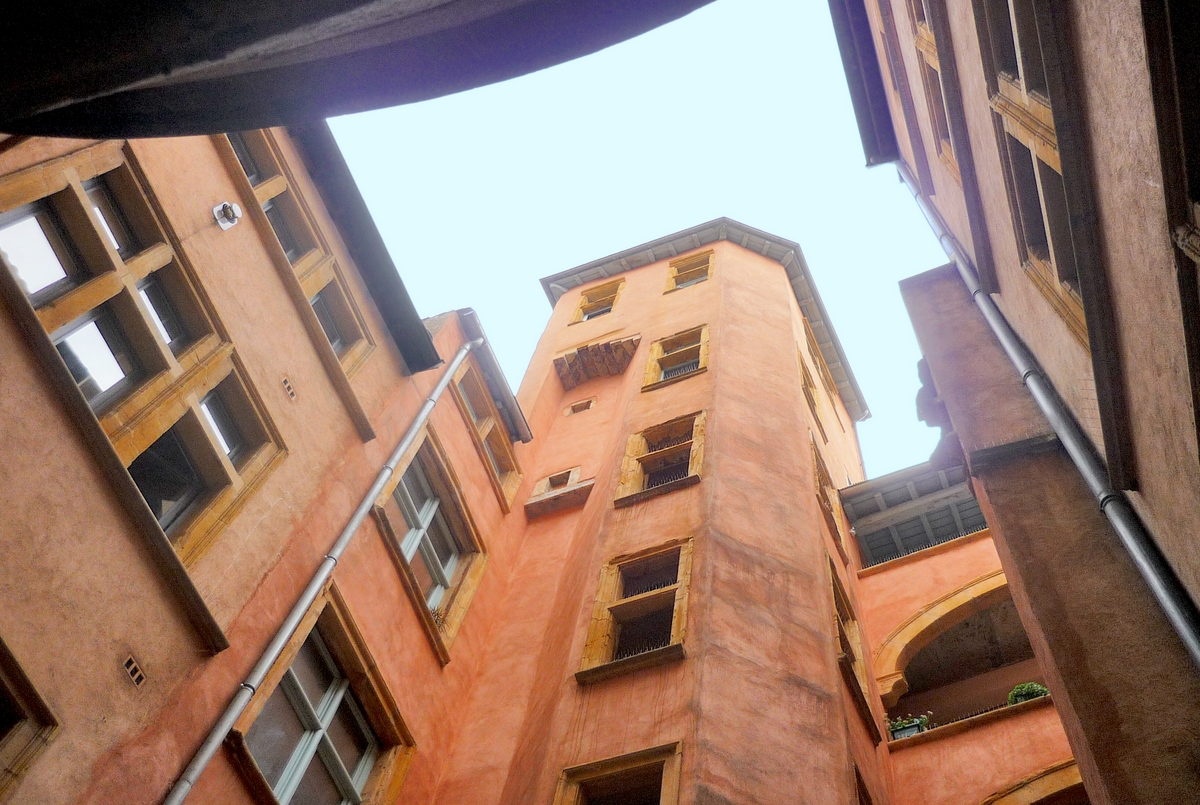
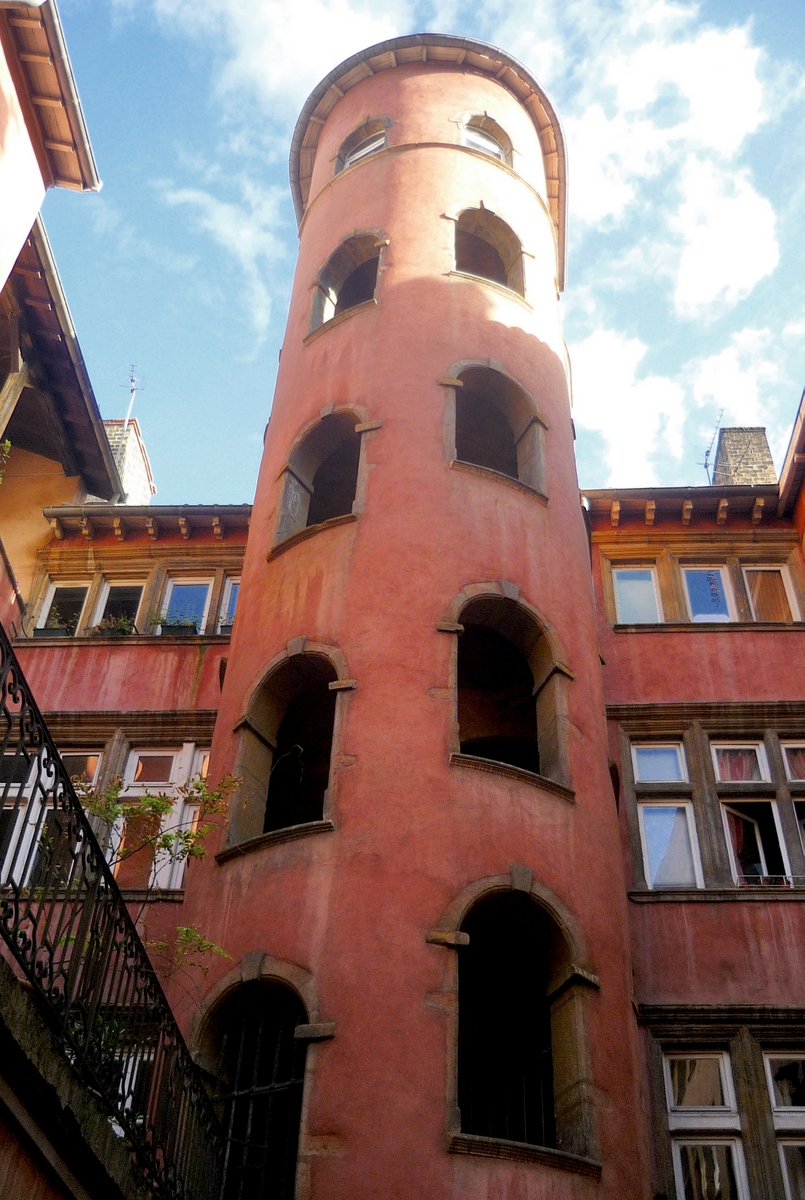
7) Palais de justice historique de Lyon
Lyon’s historical Law Courts
Almost at the south end of Rue Saint-Jean, you will reach the rear of Lyon’s historical Law Courts. The entrance is located on Quai Romain Rolland, facing the Saône River.
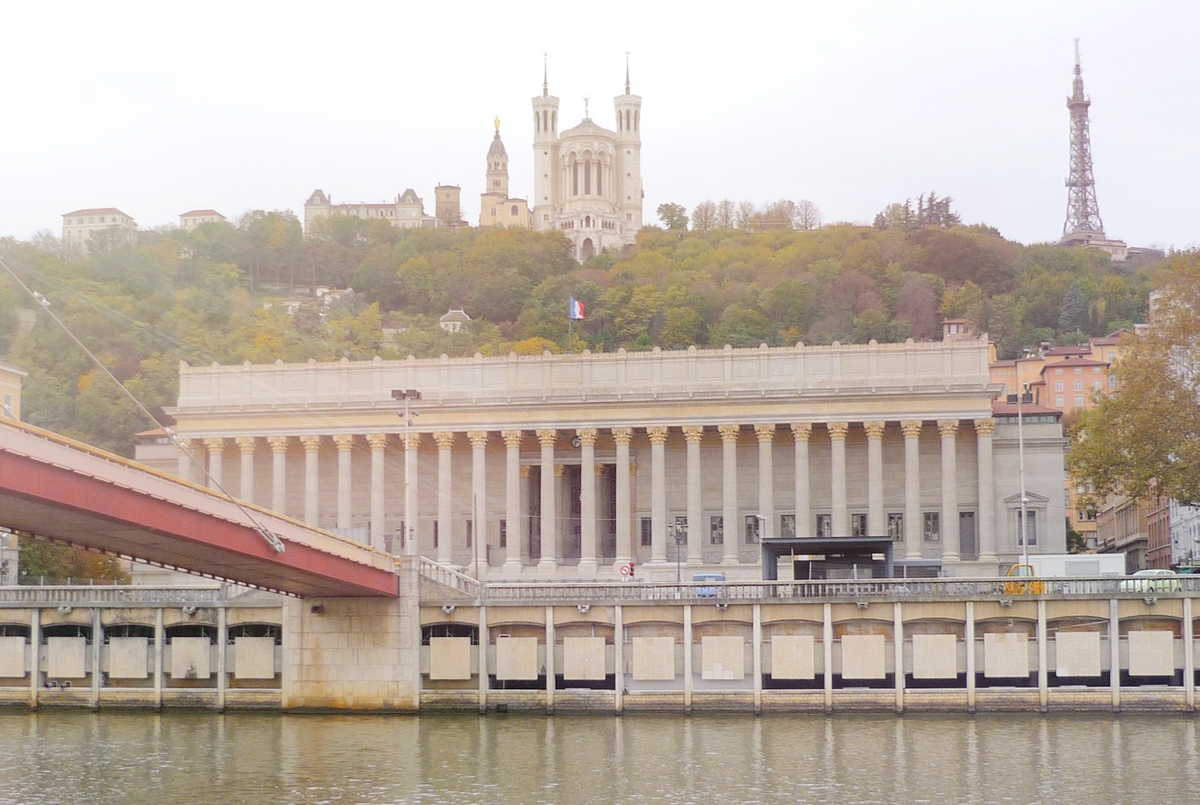
The construction of the building commenced in 1835 and lasted for seven years. Its neo-Classical style comes from architect Louis-Pierre Baltard.
The former courthouses which had stood there from the 15th century were demolished. The building is often nicknamed “Palais des 24 Colonnes” (Palace of the twenty-four columns). Indeed, 24 columns inspired by Ancient Greece and Rome decorate its frontage.

Famous trials in French history
Since the mid-19th century, these historical law courts have been the theatre of some important trials in French history, such as:
- Sante Geronimo Caserio’s in 1894 (who had shot French President Sadi Carnot in Lyon),
- Charles Maurras’ in 1945 (sentenced to life imprisonment for complicity with the enemy) and,
- Klaus Barbie in 1987 (sentenced to life imprisonment for crimes against humanity).
The French State listed the inner building as a historical monument in 1996, just a year after building a new law court in the Part-Dieu district.
While a significant monument of Lyon, the historic law courts have also remained useful. Today it is home to the Court of Appeal of Lyon and the Criminal Trial Court of the Rhône département.
8) Cathédrale Saint-Jean
St John Cathedral
Lyon’s cathedral is located in the Saint-Jean district, at the southern end of Rue Saint-Jean. It is arguably the most important building in Lyon Old Town since it gave its name to its central area and main street.
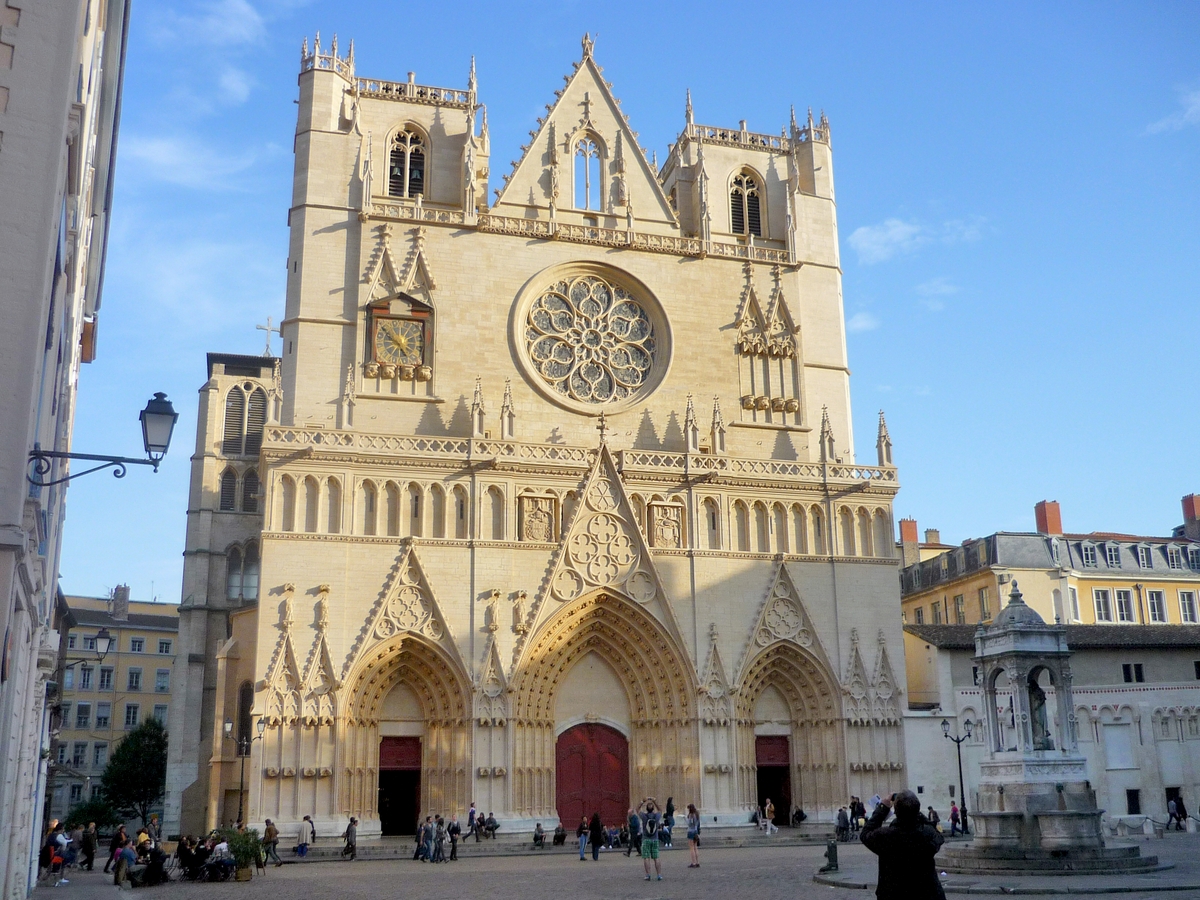
A cathedral for an archbishop
The “Cathédrale Saint-Jean” is also known as “Primatiale Saint-Jean”. This is because the Archbishop of Lyon, also called the “Primat des Gaules” (Gauls Primate), seats.
This name emphasises the importance of Lyon at the beginning of Christendom. Back then, Lyon was the capital of Gaul. That predominance remained during the early Middle Ages, and the “Gauls primate” role was introduced during the 9th century. Although it has become more symbolic, this title meant that Lyon’s Archbishop had power over other French bishops.
The edification of Lyon Cathedral
The cathedral’s construction commenced in the 12th century, inspired by the Gothic style.
It took several centuries for the cathedral to take its current shape. At first, in the 12th century, it was simply a Romanesque-style church. Then work took place in
- the nave (13th century),
- the west side of the cathedral (14th century) and,
- the side chapels (15th to 17th century).
The modest dimensions of Lyon Cathedral
The cathedral is 79 metres long and 13 metres wide, and its towers are 44 metres high.
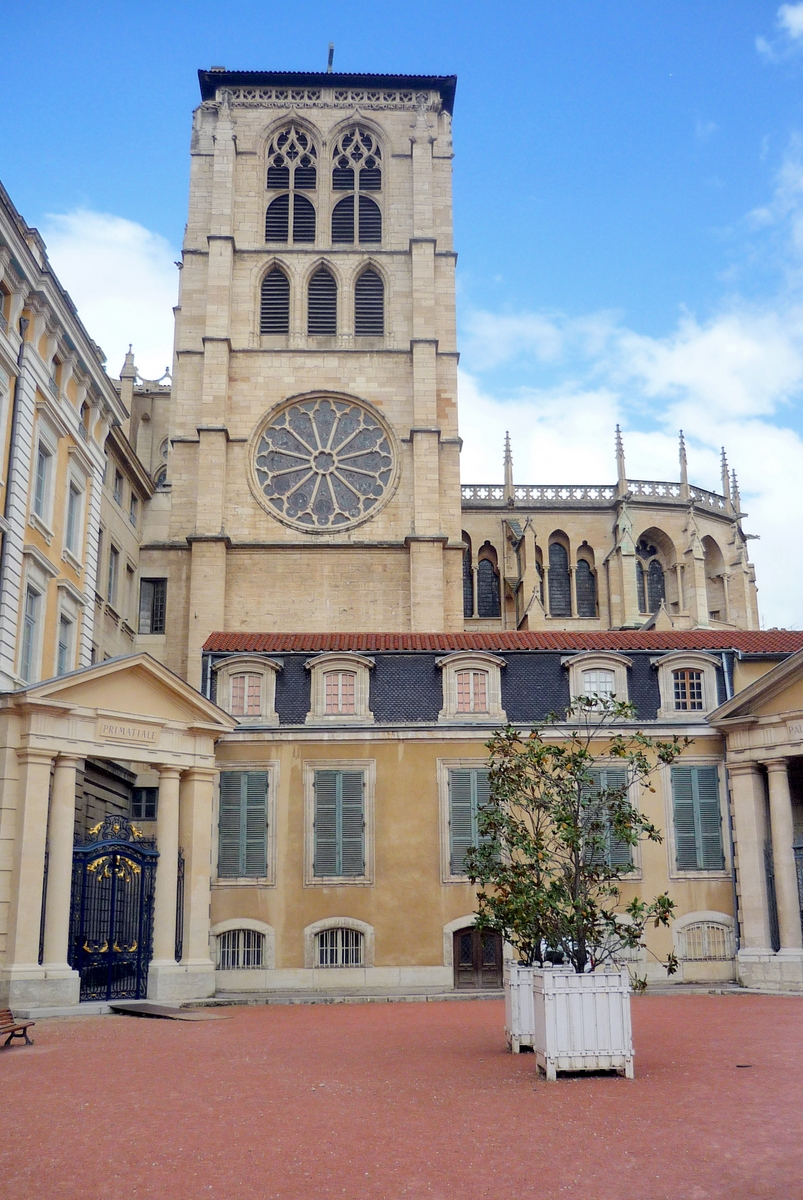
It is by far not the tallest cathedral in France. Its towers are tiny compared to Rouen Cathedral, whose tallest tower reaches 151 metres. There is at least one reason to explain this: nobody could complete the cathedral’s towers!
The astronomical clock
Lyon Cathedral is also famous for its astronomical clock.

The clock found its place inside the cathedral in 1379. It strikes every day at 12 noon, 2 pm, 3 pm and 4 pm when the automated figures spring into action.
It features:
- two angels on the clock’s sides: the one on the left turns his minute glass over while the other on the right behaves like a conductor,
- a cockerel singing,
- angel Gabriel appearing to the Virgin Mary, and
- God blessing the whole scene!
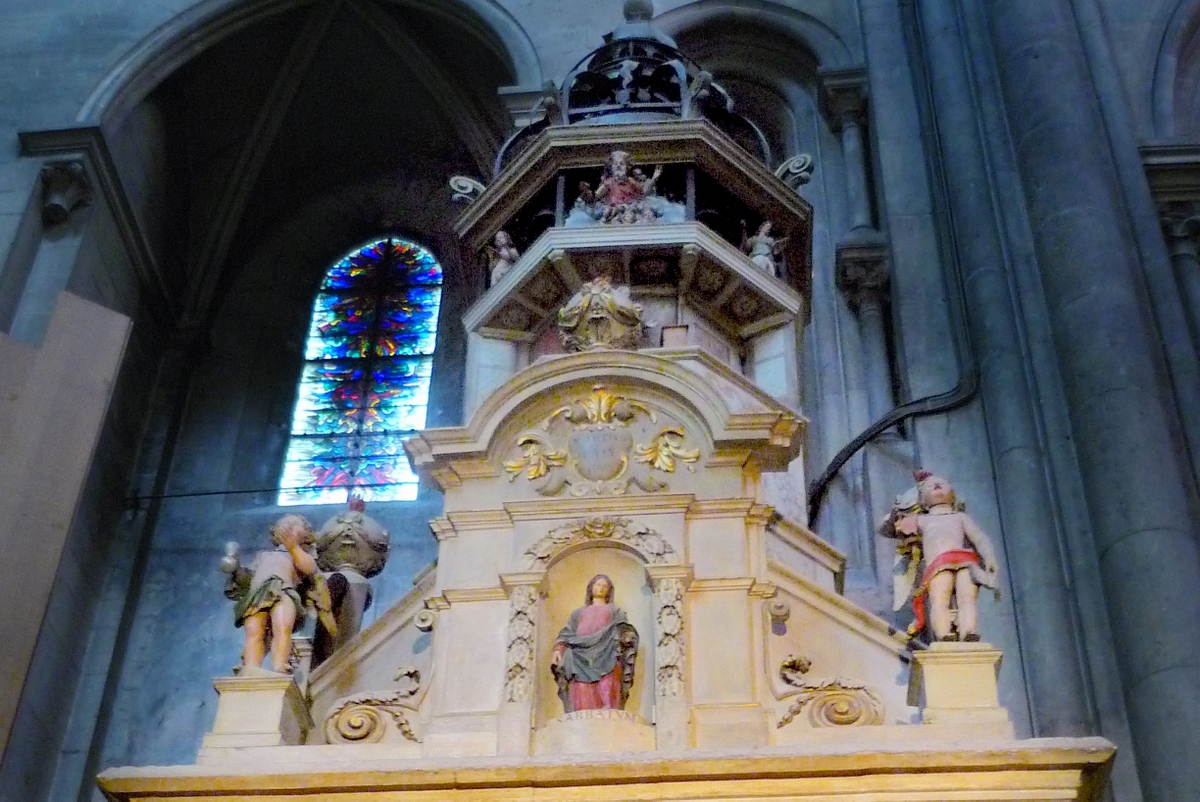
Underneath the clock, you can see the astrolabe with the moon, the sun, and the 24-hour numbers.
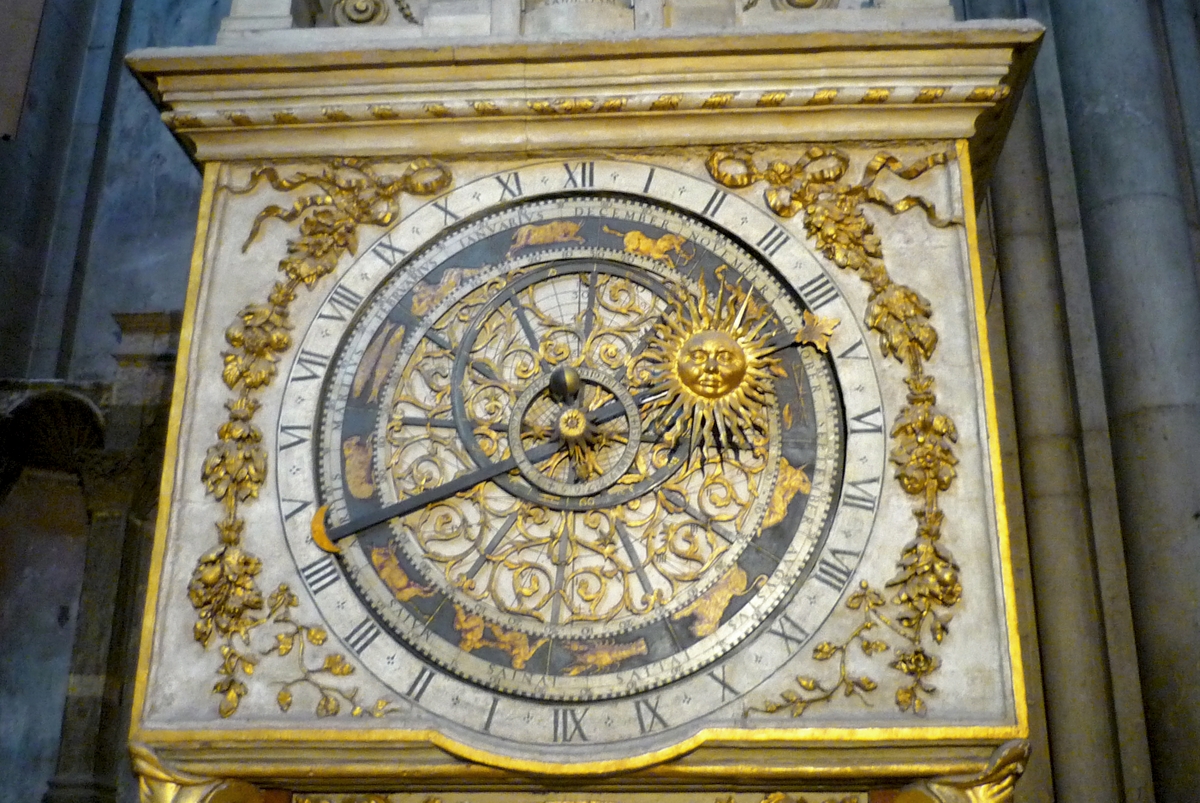
Before leaving the Saint-Jean district, don’t miss the Maison des Avocats. This is a splendid mansion from the Renaissance with a Tuscan-style courtyard. Around it are the buildings with pinky-orangey façades.
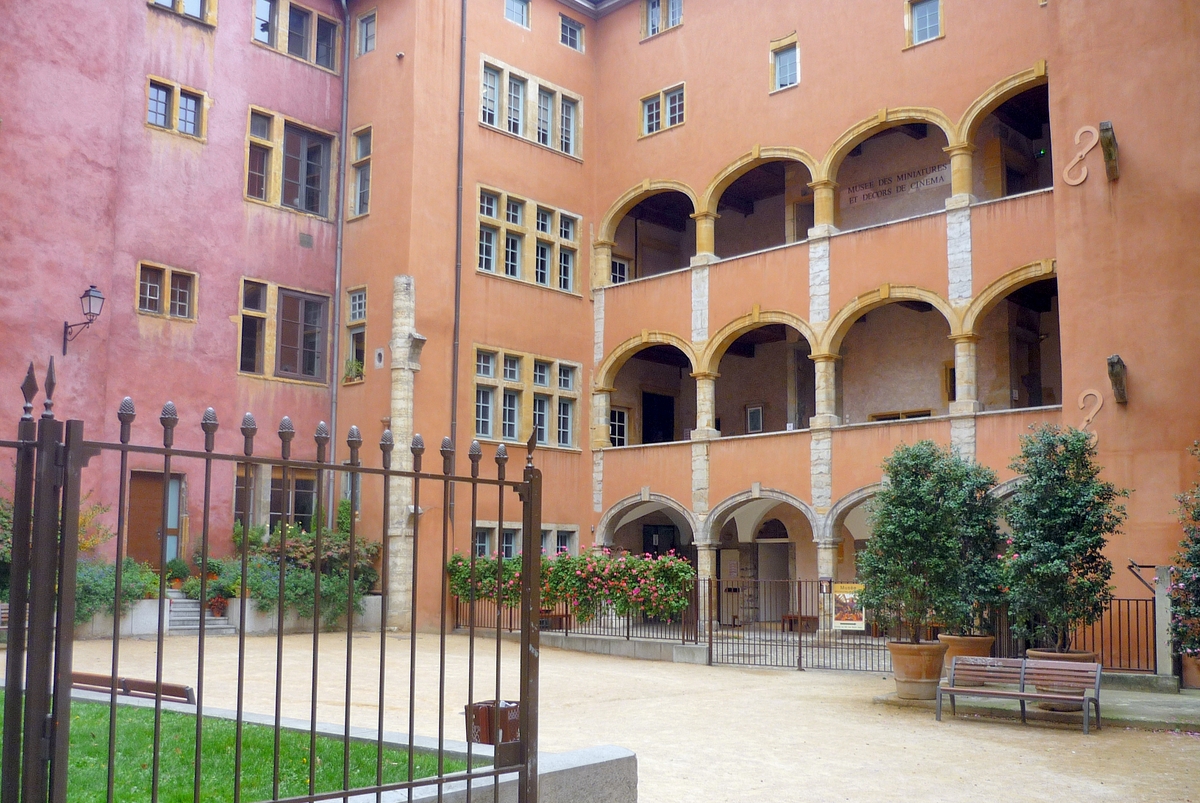
Southern Old Town: Quartier Saint-Georges
Now that we have visited the Saint-Jean district, we will discover the Southern part of “Vieux-Lyon”. Even if not the most famous part of town, there are still some great monuments and squares to discover!
Behind Lyon Cathedral, you will find the “Vieux-Lyon” underground station. You can go west to the Presqu’île, Part-Dieu district or Lyon’s Eastern suburbs. But you can also catch the funicular and climb Fourvière Hill.
9) Place de la Trinité and Rue Saint-Georges
Trinity Square and St. George Street
The south of the underground entrances stands the Place de la Trinité. It is a paved square, which gives it a very typical “Vieux-Lyon” style!
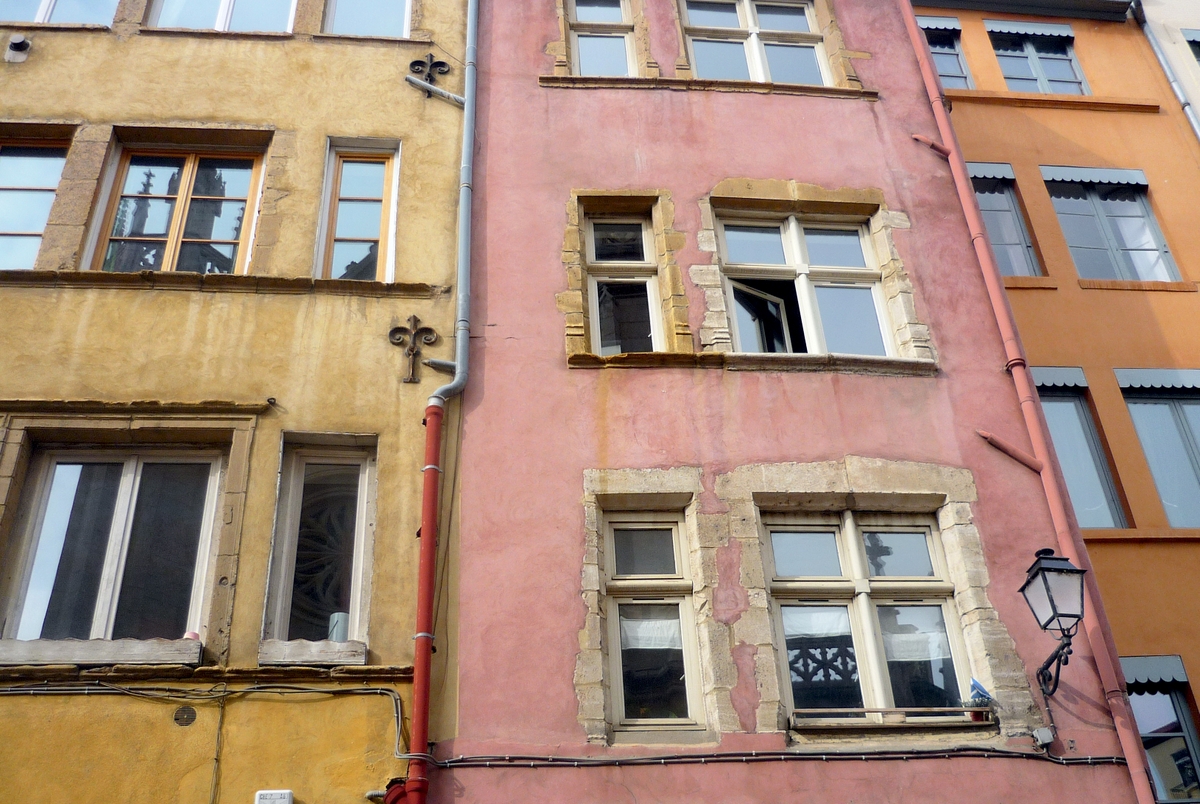
Its name comes from the Trinitarian religious order that inhabited the square. During the French Revolution, its name was briefly changed to “Place du Triangle” (Triangle Square) based on its shape.
The Bouchons of Lyon
Here, you can find one of the most famous “bouchons” of Lyon, called “La Maison du Soleil” (the House of the Sun).
![La maison de Guignol Lyon © Gonedelyon - licence [CC BY-SA 3.0] from Wikimedia Commons](https://frenchmoments.eu/wp-content/uploads/2013/05/La-maison-de-Guignol-Lyon-©-Gonedelyon-licence-CC-BY-SA-3.0-from-Wikimedia-Commons.jpg)
“Bouchons” are typical restaurants from the town, where you can usually find dishes from Lyon such as ‘salade lyonnaise’, hot, dry sausages or quenelles.
The building of La Maison du Soleil dates from 1723, when six different houses were combined.
The Bouchon is also known as “La Maison du Guignol”. Indeed, this restaurant features the traditional scenery of Guignol’s puppets show.
Consequently, this typical restaurant has also become a “café-théâtre” where you can enjoy comic one-man shows and plays by comedians from Lyon.
Old Lyon 4-Hour Food Tasting Tour
Embark on a delectable 4-hour tasting tour through the charming Lyon Old Town district and savour its diverse flavours. Led by a knowledgeable local guide, this culinary journey takes you through hidden passageways. It introduces you to the food heroes of the area, allowing you to sample their finest produce.
Highlights of the tour:
- Immerse yourself in the rich history of Lyon’s oldest district, guided by a knowledgeable local expert who knows the area inside out.
- Indulge your taste buds with a delightful array of 17 dishes and ingredients showcasing the region’s gastronomic delights.
- Meet and interact with the passionate local food heroes, gaining insights into their craft and the exceptional products they bring.
This tasting tour celebrates Lyon’s culinary heritage, offering a unique opportunity to explore the city’s gastronomic treasures and experience the authentic flavours of Vieux Lyon firsthand. Come hungry and leave with a newfound appreciation for the city’s vibrant food scene.
Rue Saint-Georges
Going South of Place de la Trinité, you will go through Rue Saint-Georges (St George Street).
It is a nice paved pedestrian street and constitutes the Saint-Georges area’s main street. As it remains relatively unknown to most tourists who visit Lyon, it is quite a peaceful street.
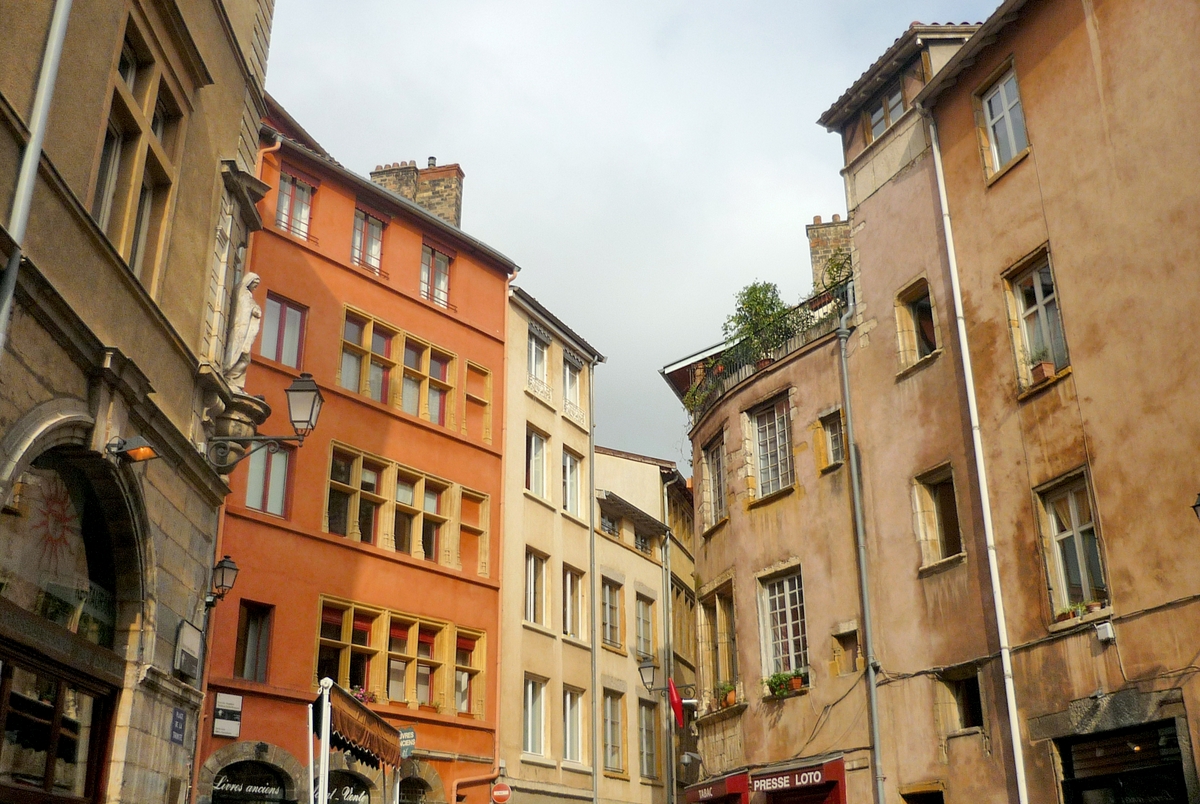
Rue Saint-Georges is undoubtedly the place to go if you want to see many old houses. You can see many buildings reaching as high as five storeys. Many “bouchons” can be enjoyed in the street.
The Automaton Museum of Lyon
At number 100 is the Automaton Museum of Lyon. This museum opened in 1991, 45 years after the creation of an automaton factory there. Many automatons were made for Christmas celebrations and the Festival of Lights. The latter is a significant day for Lyon, celebrated on the 8th of December.
The museum has a collection of 250 automatons, divided into various sections. The museum generally pleases children, mainly because a special hare and hounds game has been created for them inside the museum.
10) Eglise Saint-Georges
St George Church
Let’s end our journey through Lyon Old Town at St George Church. Despite its Gothic appearance, the church dates from 1844 from a design by Pierre Bossan, who designed the plans for Fourvière Basilica.

The former site of an old convent
The present-day church occupies the site of the old Convent of Sainte-Eulalia (6th century). The Saracens destroyed the religious institution during the 8th century. The church was rebuilt in 802 and became “St Georges”. In the 14th century, it was the base of the Knights of Malta.

Although quite a small church, it is worth seeing.
Things to do in Lyon
Looking for special and unique things to do in Lyon? Here are a few ideas:
- An Electric Ride in Lyon
- A Segway Tour of the Historic Centre of Lyon
- A Segway Tour of the Parc de la Tête d’Or
- A Dinner Cruise on the Hermès Barge in Lyon
- A Workshop and Street Art Walk around the Croix-Rousse District
- A Commented Cruise on a Barge in Lyon
For more activities and things to do in Lyon, check out the following offers:
Find out more about Lyon
- Our article about Lyon
- Our article about the Gastronomy of Lyon
- The website of the tourist office of Lyon
- The page about Lyon on Wikipedia
Pin it for later
Liked what you read about Lyon Old Town? Pin it on Pinterest:
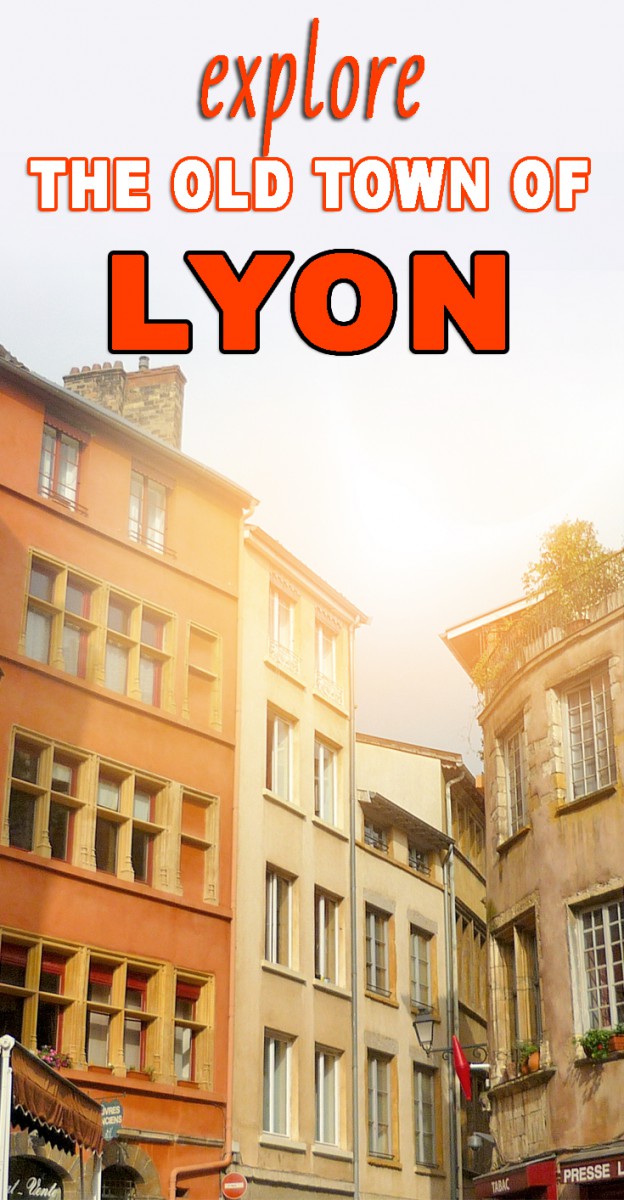





Dear Pierre, I wrote a response yesterday but after a few tries it didn’t work.
I have been silent because meanwhile my wife has been diagnosed with lung cancer phase 4 so it is a big upset for both of us. She has started treatments but it remains to be seen how much impact they will have.
More another time. Your guidance through Lyon is fantastic. I only visited once but regretfully know now how much I missed. Que sera sera. Very best wishes, Ernest
Hello Ernest… thank you so much for your comment, I’m so sorry I’m replying so late… strangely your comment just came up now. Lyon is a fantastic city to explore, and somehow little known by the mass of tourists on their way to the South.
Also just wanted to let you know I’m thinking of you both in this difficult time.
A bientôt, Pierre